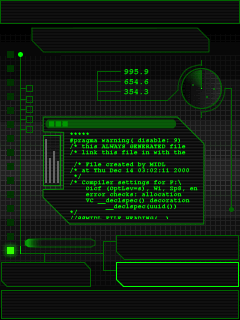Features Highlights
Scalable Solutions for Every Stage
While integrating into the regions’ critical business parts and appropriate technology solutions, we offer an uninterrupted customer choice with our professional services and services.
- Scalability & Flexibility
- Real-Time Analytics & Reporting
- User-Centric Interface

Network
End-to-End Solutions to Empower Your Business
We live our values every day. They guide us in our mission to build a safer world.

IPS
IPS (Intrusion Prevention System) is a security technology used to detect and prevent attacks on a computer network. IPS continuously monitors network traffic to detect malicious activities, suspicious behaviors, and known security threats. It also takes proactive measures against these threats to ensure the security of the network and the devices on the network.
An IPS usually detects attacks using signature-based, anomaly-based, or a combination of both. Signature-based detection recognizes previously identified attack patterns and blocks traffic that fits these patterns. Anomaly-based detection, on the other hand, monitors deviations from normal network behavior and stops such anomalous activity.
IPSs can respond differently depending on the type and severity of attacks. These responses include dropping packets to stop the attack, blocking the source, sending alerts to relevant units, or dynamically changing network policies. IPS is a critical component of network security strategies because it detects and neutralizes threats before they become attacks.
IPS is usually integrated with enterprise firewalls, UTM devices (Unified Threat Management), or security software. In this way, it protects traffic between internal networks and the public internet and secures the organization’s digital assets. IPS is an important part of modern network security structures to protect against cyber threats..

Next Generation Firewalls
Next-Generation Firewalls (NGFW) are network security solutions that offer more advanced security features and capabilities than traditional firewalls. NGFWs provide more comprehensive and effective protection by integrating multiple security technologies to monitor, control and protect network traffic against attacks.
The main features offered by NGFWs are:
Application Awareness and Control: NGFWs can perform application-based filtering and control by analyzing traffic at the application level. This provides the ability to allow only certain applications to be used or to block unwanted applications.
Deep Packet Inspection: NGFWs analyze incoming and outgoing traffic not only by their headers but also by their content. This allows malware and threats to be detected and blocked.
Integrated IPS (Intrusion Prevention System): NGFWs can detect and block abnormal activities occurring on the network by integrating with intrusion prevention systems (IPS). This helps to proactively stop malicious behavior.
VPN and SSL/TLS Inspection: NGFWs can manage virtual private network (VPN) connections and inspect encrypted traffic. This helps detect hidden threats.
User Authentication and Management: NGFWs have advanced capabilities for user authentication and access control. This is used to determine which resources specific user groups can access.
Next-Generation Firewalls are designed to meet modern business needs. With advanced security features and multi-layered protection, NGFWs provide a more resilient defense against network security threats. As such, NGFWs have become an important part of businesses’ network security strategies..

SASE
SASE (Secure Access Service Edge) is a framework that integrates cloud-based network security and access technologies. SASE helps companies and organizations adapt to changing business needs by combining network infrastructure and security services to provide secure and flexible network access.
Key features of SASE are:
Cloud-Based Approach: SASE provides security and network services in the cloud, allowing users and devices to connect securely over the Internet. This offers greater flexibility and scalability compared to traditional on-premise security infrastructure.
Secure Access and Authentication: SASE provides access control based on users’ identity, devices, and locations. Adopting Zero Trust principles, SASE uses advanced authentication and access control mechanisms to verify the user’s identity and grant access to the right resources.
Network Security and Threat Protection: SASE combines various security services such as firewall, intrusion prevention system (IPS), secure web gateway, and data loss prevention (DLP). This way, network traffic is securely monitored and protected against threats.
Advanced Connectivity and Performance: SASE manages network traffic with WAN optimization and network performance enhancing technologies. This provides fast and reliable connectivity for remote offices, mobile workers and cloud-based applications.
SASE is a security approach developed to meet the needs of the modern business world. Especially with the increase in remote working, cloud services and flexible working environments, SASE offers businesses a secure, efficient and centralized network security solution. Therefore, SASE is at the core of network security strategies for today’s businesses..

CASB
CASB (Cloud Access Security Broker) is a security technology used to control access to cloud services, increase security, and ensure compliance. CASBs monitor and manage traffic between employees, devices, and applications of companies and cloud-based services. This ensures that both corporate and personal cloud services are used securely and in a controlled manner.
The main features of CASB are:
Security and Threat Detection: CASBs ensure that security policies are enforced by controlling access to cloud services. At the same time, they monitor and detect security threats that may occur in the cloud environment. This is critical to preventing data breaches and cyberattacks.
Data Loss Prevention (DLP): CASBs monitor data transmitted to cloud-based applications and storage services and prevent sensitive information from being accessed or shared by unauthorized persons. This protects the security of confidential data and sensitive information.
Access Control and Authentication: CASBs provide user authentication and access control, ensuring that the right people have access to the right cloud resources. This makes it easier to implement identity-based security policies.
Compliance and Auditing: CASBs help companies meet legal and compliance requirements. By ensuring that specific security standards are implemented, companies are able to meet data protection and privacy requirements.
Usage Analytics and Reporting: CASBs identify anomalous activities and vulnerabilities by monitoring the usage of cloud services. They also provide detailed reports and analytics, helping companies make informed decisions about cloud security.
CASBs are an important security solution in today’s business world where cloud services are becoming more widespread. Companies are increasingly turning to CASBs to ensure that their employees use cloud resources securely and to protect sensitive data. Therefore, CASBs are a critical component of cloud security strategies..

ZTNA
ZTNA (Zero Trust Network Access) is a security model and technology used to control network access and provide security. Unlike traditional network security approaches, ZTNA is based on the principle of “trust nothing, verify everything”. This approach ensures that access requests are continuously verified based on factors such as user identity, device status, and context.
Key features and advantages of ZTNA are as follows:
Identity-Based Access: ZTNA allows users to access only authorized resources after verifying their identity. Authentication is usually supported by multi-factor authentication (MFA), which increases the level of security.
Context and Policy-Based Access: ZTNA evaluates access requests with contextual information such as device type, geographic location, time, and user role. In this way, security policies become flexible and adaptable.
Stealth Network Access: ZTNA increases security by preventing direct access to resources. Users can only access resources they are authorized to and cannot access resources that are invisible on the network. This makes it harder for external attackers to infiltrate the network.
Advanced Threat Detection and Response: ZTNA continuously monitors access requests and quickly detects anomalous activities. This allows proactive responses to security threats.
Cloud and Remote Work Support: ZTNA securely supports cloud-based services and remote workers. This overcomes the limitations of traditional on-premise security approaches and adapts to modern business needs.
ZTNA is a critical component of modern network security, helping companies build a secure and resilient network infrastructure. Going beyond traditional network security boundaries, ZTNA is an essential solution for business continuity and digital transformation..

LAN-WAN-WLAN Technologies
LAN (Local Area Network), WAN (Wide Area Network) and WLAN (Wireless Local Area Network) are the basic network technologies that enable communication between computers and other devices. Each offers different coverage and usage areas, enabling various network structures for businesses and individuals.
LAN (Local Area Network): A LAN is a type of network that connects computers and devices within a local area. It usually covers a limited area such as an office, school or home. LANs offer high-speed data transfer and low latency. They physically connect devices using wired connections (Ethernet). LANs are commonly used to create local networks for small and medium-sized businesses.
WAN (Wide Area Network): A WAN refers to networks that are geographically spread over a large area. It can cover a city, country or intercontinental regions. WANs create a large network by combining different LANs. This is usually done over the internet or private leased lines. WANs are suitable for extended business networks, global companies and long-distance communication needs.
WLAN (Wireless Local Area Network): WLAN connects devices together in a local area using wireless technology. WLANs transmit data via radio waves and generally use the Wi-Fi standard. WLANs eliminate the need for cables, providing flexibility for mobile devices, laptops, and other portable devices. They are widely used in homes, offices, cafes, and public areas.
These network technologies form the basis of modern communication and offer a variety of solutions for different needs. While LAN provides local connectivity and high-speed communication, WAN covers large areas and enables long-distance communication. WLAN offers the advantage of wireless connectivity and mobility. These technologies can be used together or separately to create flexible network structures that suit the needs of businesses and individuals..

Network Access Security (NAC)
Network Access Security is a set of policies, procedures, and technologies used to control access to a computer network, prevent unauthorized entry, and protect network resources. This security approach is critical to ensuring the security of data and devices on the network and forms part of the defense line against cyber threats.
Network access security consists of the following basic components:
Authentication and Authorization: The basis of network access security is to verify the identity of users and allow only authorized individuals to access the network. Security levels can be increased by using technologies such as multi-factor authentication (MFA).
Access Control Policies: Access control is used to determine which users can access which resources and data. These policies can be tailored to users’ roles, locations, device types, and other factors.
Network Segmentation: The division of a network into different sections to increase network access security. Segmentation prevents the spread of attacks and limits access to sensitive data. Virtual local area networks (VLANs) and network microsegmentation are used for this purpose.
Firewalls and IPS/IDS: Firewalls monitor network traffic and block dangerous or unauthorized activity. Intrusion prevention systems (IPS) and intrusion detection systems (IDS) increase security by detecting attacks and anomalous behavior on the network.
Encryption and Secure Communications: Encryption is used to secure data transmitted on the network. Technologies such as virtual private networks (VPNs) and secure transport layer security (TLS) prevent data theft by encrypting network traffic.
Network Access Security is vital to modern businesses and organizations. A well-implemented network access security strategy protects the integrity and security of the network by preventing data breaches, unauthorized access, and cyberattacks. It also helps meet legal and compliance requirements.

Network Packet Distribution (Packet Brokers)
Network Packet Brokers are a network device used to monitor and analyze network traffic. These devices collect, filter, and distribute data packets from the network to different analysis or monitoring tools, helping to improve the performance and security of the network. Network Packet Brokers are critical for network administrators and security teams because they provide a centralized platform to monitor and analyze traffic on the network.
The main functions of Network Packet Brokers are:
Traffic Collection and Copying: Packet distributors collect network traffic through physical links or port mirroring feature of network switches. The collected traffic is copied to be forwarded to different analysis and monitoring tools.
Traffic Filtering and Forwarding: Packet distributors filter and filter network traffic based on certain criteria. These criteria may include protocol types, IP addresses, port numbers, and other parameters. The filtered traffic is directed to the appropriate analysis or monitoring tools.
Load Balancing and Traffic Distribution: Network Packet Distributors provide load balancing by distributing traffic evenly across multiple monitoring or analysis tools. This ensures that traffic is distributed evenly across different systems and prevents overload at a single point.
Traffic Manipulation and Decryption: Some packet distributors can manipulate traffic to mask sensitive data or decrypt encrypted traffic. These features can be used to meet security and compliance requirements.
Network Packet Distributors are a valuable tool for network security and performance analysis. They play a critical role in monitoring security events, detecting network problems, and meeting compliance requirements. Packet distributors help manage the complex traffic of large networks and data centers, ensuring a reliable and secure network environment..

ICS and SCADA Security
ICS (Industrial Control Systems) and SCADA (Supervisory Control and Data Acquisition) systems are technologies used for the management of industrial processes and critical infrastructures. They are widely used in critical sectors such as electrical grids, water treatment plants, oil and gas lines, and manufacturing facilities. ICS and SCADA security is vital to protect these systems from cyber attacks and other threats, as such attacks can cause large-scale disruptions and damage.
The main elements of ICS and SCADA Security are:
Network Isolation and Segmentation: Isolating ICS and SCADA systems from general networks increases security. Network segmentation allows systems to operate at different security levels and prevents threats from spreading.
Access Control and Authentication: Strict access control policies should be implemented to allow only authorized personnel to access these systems. Multi-factor authentication (MFA) and role-based access control (RBAC) increase access security.
Firewalls and IDS/IPS: Firewalls protect ICS and SCADA systems from unauthorized access. Intrusion detection and prevention systems (IDS/IPS) monitor anomalous activities and block potential attacks.
Monitoring and Logging: Continuous monitoring of EKS and SCADA systems helps detect anomalous behavior. Comprehensive logs should be kept to investigate security incidents.
Patch Management and Security Updates: Security updates and patches should be applied regularly to fix vulnerabilities in EKS and SCADA systems. This strengthens defense against cyber threats.
Training and Awareness: It is important to train and raise awareness of personnel managing EKS and SCADA systems on security issues. Compliance with security rules reduces risks caused by human errors.
Disaster Recovery and Business Continuity: Disaster recovery and business continuity plans should be created against interruptions that may occur in EKS and SCADA systems. This ensures that critical services are restored quickly.
EKS and SCADA Security is important for ensuring the security of critical infrastructures. With the increase in cyber threats, a comprehensive and proactive security approach is required to protect industrial control systems. These security measures are necessary to ensure the safe, reliable and uninterrupted operation of critical infrastructures..

Content Filtering (Proxy)
Content Filtering (Proxy) is a security technology used to control internet traffic and block unwanted or harmful content. A proxy acts as a middleware to manage users’ internet access and provides network administrators with powerful tools to filter and monitor web traffic. Content filtering is an important security measure for businesses, schools, and other organizations because it protects users from dangerous content and ensures compliance requirements are met.
The main functions and features of content filtering are:
URL and Domain Filtering: Content filtering can block access to specific websites and domains. This helps to block harmful or inappropriate content from users.
Category-Based Filtering: Proxies can divide websites into different categories, limiting users’ access to sites in specific categories. For example, categories such as adult content, gambling, or social media can be filtered.
Content Analysis and Security Checking: Proxies can analyze the content of web pages to detect malware, phishing, and other security threats. It can also protect against SSL/TLS-based threats by analyzing encrypted traffic.
User Authentication and Policy Enforcement: Proxies can apply access policies to specific user groups or individuals by verifying the identity of users. This increases access control and security.
Logging and Reporting: Content filtering monitors network traffic and generates comprehensive logs and reports on user activity. This provides network administrators with information for security audits and compliance requirements.
Content Filtering (Proxy) helps businesses and organizations increase network security, protect users from malicious content, and meet regulatory compliance requirements. It also limits access to specific types of content to increase employee productivity, enabling more efficient use of resources. Proxy-based content filtering is a critical component of modern network security and an important line of defense against cyber threats..

Network Performance Management (NPP)
Network Performance Management (NPP) is a set of tools and techniques used to monitor, analyze, and optimize the performance of a computer network. The main purpose of NPP is to detect potential problems in the network, ensure efficient use of network resources, and improve the overall performance of the network. This process helps network administrators to better understand the network infrastructure and take measures to improve performance.
The main functions and components of Network Performance Management are:
Network Monitoring and Visualization: NPP tools continuously monitor network traffic and devices and provide real-time information about the status of the network. Network administrators use these visualizations to monitor traffic flow, bandwidth usage, and connection status.
Traffic Analysis and Bandwidth Management: NPP analyzes network traffic to detect high-bandwidth applications or abnormal traffic patterns. This information is used to optimize network resources and control bandwidth usage.
Alerts and Anomaly Detection: NPP tools continuously monitor network performance and generate alerts when certain thresholds are exceeded. This allows network administrators to detect and intervene in potential problems at an early stage.
Capacity Planning and Scaling: NPP evaluates the current capacity of the network to plan for future needs. This facilitates scalability and growth of the network.
Troubleshooting and Root Cause Analysis: NPP tools are used to identify and troubleshoot the source of network performance issues. This is critical to quickly resolve network outages and service quality degradations.
Network Performance Management is essential for managing the complexity of modern networks and optimizing network performance. A good NPP strategy helps to detect network problems in advance, improve network performance, and maintain uninterrupted business operations. It is also an important tool for ensuring efficient use of network resources and improving user experience..

SD-WAN
This approach provides a software-based solution for managing and optimizing traditional wide area networks (WANs). SD-WAN aims to manage network traffic more intelligently, use bandwidth efficiently, and improve the performance of wide area networks.
The main features and benefits of SD-WAN are:
Centralized Management: SD-WAN provides network traffic management and control from a central control point. This allows network policies and priorities to be set from a central location.
Optimized Traffic Management: SD-WAN intelligently manages and optimizes traffic. This ensures high performance of critical applications and efficient use of bandwidth resources.
Wide Access Options: SD-WAN supports multiple connection types, giving organizations the flexibility to use different connectivity options such as dedicated lines, DSL, wireless, and cellular networks.
Redundancy and Rapid Recovery: SD-WAN can quickly recover by automatically changing traffic routing when a network fault or outage is detected.
Enhanced Security: SD-WAN solutions provide the ability to better monitor network traffic and enforce security policies. This creates more effective protection against cyber threats.
Cost Savings: SD-WAN can reduce costs for organizations by more effectively utilizing network bandwidth resources. Especially if organizations use high-cost connections such as dedicated lines or MPLS to manage their wide area networks, SD-WAN can reduce these costs.
SD-WAN is often an important technology for large organizations, branch offices, data centers, and organizations looking to improve connectivity to cloud services and increase network performance. This approach makes network management more flexible and efficient, while also improving business continuity and security..
Professional Infrastructure Services
Backup And Archiving Architecture Consultancy
Experts Team
Backup and Archiving Solutions:
Our Annanowa team, which we position separately as an expert in Backup and Archiving within Annanowa, offers backup and archiving services with many market-leading software, from basic backup tasks to application-specific solutions, as well as new generation products and solutions in other areas.
Backup Services:
The Annanowa team analyzes the backup plans of institutions and organizations and helps create an organization that will minimize the risk of data loss with its experience in the sector. We provide services with our experienced team in backup processes such as choosing backup software and organizing onsite/offsite copies.
In addition to providing services for market-leading solutions such as Commvault Simpana, Veeam, Networker, which we have been using in corporate companies for a long time, as a team; we also undertake successful projects with new generation manufacturers such as Cohesity, Rubrik.
Archiving Solutions:
As Annanowa, we position market-leading software, primarily Veritas Enterprise Vault, in the field of archiving. Veritas Enterprise Vault provides a platform to store, manage, and easily find unstructured data across the enterprise. Enterprise Vault reduces the size of primary storage and applications by removing email messages and files, deduplication and compression of data, and creating an easy-to-retrieve index of all archived information.
Business Continuity And Disaster Recovery Process Consulting
40+ Years in Industry
Within Annanowa, this focused Annanowa team area is separated by team members who have signed many projects, how is the situation in the preparation of Business Continuity (BC) and Disaster Recovery (DR) plans. We ensure that these features emerge by sharing our past experience in detail, and we guide in creating the most suitable business continuity or disaster recovery scenarios for storage.
With our product knowledge and experience developed for Business Continuity and Disaster Recovery solutions:
Analysis of systems from a continuity (High Availability) perspective
Protection of critical data
Run backup plans &
Decision making and making suitable backup and replication hardware available
Disaster Recovery Center (Disaster Recovery Center) analyses
Planning and implementing business continuity results such as Active-Active & Active-Passive or 3 Data Centers (3DC)
Disaster Recovery tests
We assist in the continuation of all backup and business continuity works as recoverable.
System Design And Architecture Consultancy
Products Download
It refers to a type of service that provides professional guidance and consultancy services to organizations or individuals on planning, designing and optimizing their information technology (IT) infrastructures. This service provides first-class expertise and consultancy to meet the IT requirements of organizations or projects, create system designs that comply with best practices and improve existing infrastructures. System design and architecture consultancy includes the following important components:
Requirements Analysis: Consultants perform requirements analysis to understand the clients’ business goals and IT needs. This is used to determine what systems and solutions are required.
System Design: Consultants design customized IT systems and infrastructures. This includes how to configure physical and virtual servers, network structures, storage solutions and other components.
Infrastructure Architecture: Architects plan how all systems and components will come together and work effectively. This aims to provide a scalable and secure infrastructure.
Technology Selection: Consultants select the most appropriate hardware and software technologies. This includes determining which ones fit the client’s needs and budget.
Security and Compliance: System design and architecture consultants consider data security measures and compliance requirements. This includes protecting sensitive data and complying with legal requirements.
Performance Optimization: Consultants make adjustments to ensure systems and networks perform at high performance and operate efficiently.
Backup and Disaster Recovery: Consultants create data backup and disaster recovery strategies. This includes preventing data loss and ensuring business continuity.
Sustainability and Scalability: Architects make their designs sustainable and scalable to ensure infrastructures are fit for future growth and development.
Documentation and Training: Consultants provide project documentation and user training to clients. This facilitates effective use of systems and applications.
System design and architecture consulting can help organizations optimize their technology infrastructure, ensure business continuity, achieve cost savings, and do business more effectively. This type of consulting helps organizations compensate for their lack of expertise and successfully complete complex technology projects.
System Design
Happy Customers
System Design is a process used to plan and create the components of a system and how they interact.
Systems can consist of a variety of elements, such as software, hardware, human resources, and processes.
System design aims to create a framework to ensure that these elements operate efficiently, functionally, and reliably.
The design process may vary depending on the purpose and requirements of the system,
but generally includes the following stages:
Requirements Analysis: The first step in system design is to determine what the system must accomplish and
analyze the needs of the users. This stage defines the scope of the system and its basic requirements.
High-Level Design: In this stage, the overall structure of the system and its main components are determined.
The high-level design creates the architecture of the system and defines the basic interactions between the components.
Detailed Design: In this stage of system design, the technical details and specifications of the components are created.
This can include various levels of detail, from software classes to hardware structures.
Interface Design: In system design, the focus is on how components and subsystems communicate with each other. Interface design determines how data and commands are transferred between components.
Modularity and Scalability: A good system design is based on the principles of modularity and scalability.
Modularity allows the components of the system to be developed and changed independently.
Scalability refers to the system’s capacity to grow and adapt to changing requirements.
Security and Reliability: System design takes into account security and reliability issues. Security ensures that the system is protected against unauthorized access and threats.
Reliability refers to the stable and uninterrupted operation of the system.
Testing and Verification: In the final stages of system design, various tests and verification processes are performed to test the accuracy and functionality of the design. This checks whether the system complies with the requirements and
whether there are any errors.
System design plays a critical role in complex projects, and a successful design ensures the long-term success
and sustainability of the system. Good system design is a fundamental step in creating an efficient and secure system that meets user requirements..
Backup – Archiving
Email and File Archiving
It is the process of storing and managing electronic mail (e-mail) messages, attachments, and related information in a specific order. This process is important for organizations, individuals, or institutions. E-mail communication needs to be recorded and regularly accessible for a number of reasons, including business continuity, providing evidence, and legal requirements.
Basic concepts and reasons for email archiving:
Archiving Process: Email archiving refers to copying and storing selected emails from a specific date range or category. This process does not require removing emails from their original mailboxes and is usually copied to a lower priority data store.
Providing Evidence: Email archives are used to meet legal requirements and provide evidence. Especially in legal disputes, legal investigations, or lawsuits, emails are important for documenting and verifying events.
Business Continuity: Email archives are intended to provide business continuity. In the event of a disaster or data loss, backup copies of lost/damaged emails can be restored from the archive.
Legal Requirements: Some countries and industries have legal requirements for email archiving. These requirements are especially common in areas such as finance, healthcare, the public sector, and law.
Data Management and Organization: Email archives are used to organize, index, and control access to emails. This makes emails easily searchable and findable when needed.
Reducing Overload: Archiving emails is a common practice to reduce unnecessary load on email servers. This helps servers run faster and is more efficient.
Email archiving ensures that email communication is managed effectively, data loss is prevented, or emails are stored in a manner that complies with legal requirements. Organizations can use email archiving software that automates and streamlines this process. These software can automatically categorize emails, archive them according to certain criteria, and facilitate search and analysis by providing quick access to data.
File Archiving is the process of organizing and storing files in a certain order to preserve data for a long time and make it easily accessible. This process is usually used in businesses and organizations to store old or infrequently used data, while preventing data loss and providing quick access to documents when needed.
File archiving can be done in physical and digital formats. While physical archiving is done by placing paper documents in filing systems, digital archiving involves storing electronic files on various platforms such as hard drives, cloud storage, or special archiving software.
Archiving helps reduce storage costs by compressing files to take up less space and storing data securely. In addition, file archiving is important for meeting legal regulations and compliance requirements. In this way, it is possible to access data quickly even after a certain period of time.
File archiving allows businesses to better manage data, prevent information loss, and easily find documents when needed. An archiving strategy is an important tool for organizations to meet their information storage needs, and a well-implemented file archiving system can increase the efficiency of business processes


Backup – Archiving
Server and End User Backup
Server and End User Backup is an important data protection strategy used by businesses to protect their critical servers and end user devices. This approach minimizes data loss and ensures business continuity by backing up both the server infrastructure and users’ personal computers.
Server backup involves backing up databases, applications, and other critical system components hosted on servers at regular intervals. These backups prevent data loss in the event of a disaster and allow servers to be quickly re-established. In addition, server backup helps businesses continue their operations in extraordinary situations such as system failures, cyber attacks, or natural disasters.
End user backup allows businesses to back up data on employees’ desktops, laptops, and other personal devices. This protects important files, documents, and other information from employees, and makes it easier to restore critical information in the event of data loss. End user backup increases employee productivity while also raising the data protection standards of the business.
Server and End User Backup is an important part of a business’ data protection strategy and is a key element of business continuity. Thanks to these backup solutions, your business data is safe and you can respond quickly and effectively to unexpected situations..

Backup – Archiving
High Performance Backup Units
High Performance Backup Units are high-capacity, high-speed storage devices designed to back up large amounts of data quickly and efficiently. These units are typically used to securely protect and quickly restore critical data in businesses and data centers. High-performance backup units meet modern business needs by offering wide bandwidth, high data transfer speeds, and advanced security features.
These backup units provide redundancy using technologies such as RAID (Redundant Array of Independent Disks) to prevent data loss. They also support business continuity with features such as snapshots, automatic backup scheduling, and rapid restore. High-performance backup units are often a critical part of large businesses and corporate data centers because they are specifically designed to back up and restore large data sets in a short time.
These units, which minimize performance loss during backup operations and use system resources effectively, are an important component of business continuity and disaster recovery strategies. They also protect data from unauthorized access with security features such as data encryption and user authentication.
With High Performance Backup Units, businesses can secure critical business information by accelerating data backup and restore processes and continue their operations in the face of unexpected situations. These units provide a reliable and efficient backup solution for businesses with high volumes of data.
SAP Solutions:
Your Business Solutions Consultant Caglar Arlı …
Caglar Arlı offers solutions to thousands of customers since 2000, adding value with a perfectionist perspective. Caglar offers a superior experience to its customers with an unusual consulting mentality and offers a high return on Investment Return. In addition to its implementation consultancy, it also positions SAP projects as investment, not expense, through the experience of process consultancy.
Universities, public and municipalities, consumer products and Rapid Deployment Solution (RDS) methodology of SAP for these sectors. Cost and time saving approach based on experience makes a difference in the minimum project risk with SAP consulting services in Turkey. Caglar, which publishes its own products in the SAP Store, presents Turkish engineers’ products all over the world.
What is SAP?
SAP (Systems, Apllications and Products), headquartered in Walldorf Germany and an office in more than 130 countries, is the world’s leading provider of enterprise business software. SAP is the 4th software company in terms of turnover, and SAP, which is located in 4 different geographical areas, offers company software applications to various companies.
How SAP is a Program?
SAP is business solution software that supports companies in implementing company strategic plans, building high system performance, making fast and effective decisions, and meeting key business objectives. SAP has various products. These,
ERP (Enterprise Resource Planning)
CRM (Customer Relationship Management)
SRM (Supplier Relationship Management)
SCM (Supply Chain Management)
BOBJ (Business Object)
XmII (Manufacturing Integration and Intelligence)
Enterprise Central Component (ECC)
What is SAP Consultant?
They are consultants who bridge the existing processes of the companies with SAP processes and support the smooth transition of the process. SAP consultants are divided into module modules such as FI consultant, PP consultant, MM consultant.
It is not enough for SAP consultants to specialize in MCIs, but they also need to be certified as experts in the modules concerned. It is very difficult to find a certified SAP Consultant in our country today, companies are in serious position needs in this field.
With the experience of ages, SAP offers certified trainings while doing full cycle projects.
Customer Relationship Management [CRM]:
SAP Customer Relationship Management (CRM) provides you with insights and estimates of what your size customer needs will be, and what you will need to build long-term, profitable relationships with your customers. SAP CRM solutions enable you to combine employees, partnerships, processes and technology. Once they are able to convert shoppers.
Marketing, Sales, Service, Analytical, Field Services, E-Commerce, Customer Service Center Services and Management and Channel Management.
The customer association cycle takes place at every step of the cycle by providing you with all the features and functionality you need, such as marketing planning, campaign management, tele selling, and segmentation by the lead.
SAP CRM and real-time availability controls allow contact management, billing management, order fulfillment monitoring, and order tracking. In addition to SAP CRM you can deal with all the channels instantly, such as customer interaction center, Web-based customer self-service features, service and complaint management, field service and distribution, management.
Supply Chain Management [SCM]:
With the SAP Supply Chain Management solution, we provide you with all the features you need to design and operate your future supply chain. SAP Supply Chain Management; providing a robust coordination that provides you with the features that determine the processing exceptions, monitoring finance, information and substance processes. The coordination features of SAP Supply Chain Management help you to transform your flat and sequential supply chains into adaptable supply chain networks that provide a dynamic, multi-domain environment. SAP Supply Chain Management enables departments, business units and corporations to predict problems in a short period of time, quickly arrange programs and processes, and manage the extended supply chain more effectively, enabling them to gain greater visibility in stocks, planning and programming.
SAP Supply Chain Management also covers other supply chain planning, execution and collaboration from the coordination. As an excellent supply chain solution, this product has been strengthened by proven methods and industry expertise acquired over thirty years in the field of supply chain leadership.
Business Intelligence [BI]:
SAP Business Intelligence solutions enable you to make effective, informed decisions based on tangible data and analysis. All users in different levels can benefit from the Business Intelligence solutions to access the information they need without being dependent on IT resources and developers. The networks contribute to making strategic decisions by transforming information, knowledge into decisions with Arli’s SAP Business Intelligence solutions. You can make quick and accurate decisions by analyzing real-time, consolidated, accurate data, summary and different breakdowns. You can also minimize errors by making simulations for future plans. You can access your Business Intelligence applications from any device (computer, tablet, phone) wherever you want, regardless of location and device.
With Caglar Arlı consultancy, all of the users in your enterprise can access, format, analyze and share information across the organization based on their level of authority. SAP Business Intelligence solutions enable you to:
Reporting: You can access the corporate data in reports to gain a more comprehensive understanding.
Interactive Analysis: You can use self-service business intelligence tools to answer instant queries and analyze data.
Advanced Analysis: You can determine trends from past data and predict potential gains.
Dashboards and visual elements: You can use interactive models to easily convert complex data into visual elements.
Data Discovery: You can combine Internet speed with the power of business intelligence to find instant answers to business questions.
Information Infrastructure: You can use a single information infrastructure to ensure that the right data is delivered to the right users at the right time.
Enterprise Resource Planning [ERP]:
Enterprise Resource Planning (ERP) is the common name for solutions that bring together companies to gain competitive advantage and ensure the efficiency and integration of operational processes, enabling the integration of all financial, human resources, accounting, production and logistics processes in general.
SAP has been providing its enterprise resource planning (ERP) solutions from its tens of thousands of customers since 1972, with its competent consultant staff since different years.
Caglar offers special solutions for you by understanding your needs with the principle that Information Technologies should always be in a structure that facilitates your business activities, adds value and develops value.
With SAP Enterprise Resource Planning, you can manage, monitor and report all your processes through a single, integrated infrastructure.
Having signed many firsts in the field of Food, Education and Public Affairs, Çağlar also has process consultancy as well as application consultancy in its projects.
-

Atlassian Magicer Global DDoS Protection | Global Network Security
Threat Deception and Honey Trap SolutionIt has become almost certain that attackers posing a threat to institutions or organizations will enter the network structure. An advanced method used to…
-

Nanodog FireWall MITRE ATT&CK Framework And Magic Quadrant Automate
Firewall/Network Configuration and Change ControlInformation infrastructures, there may be firewalls, attack prevention systems and network products from many different manufacturers. The compliance of the configurations on these components with…
-

Network Watcher And SOAR The Future of Security
Network Performance MonitoringProblems experienced in network infrastructures should be detected before they affect the workflow. It is important to understand whether a problem experienced in the application is caused…
-

Network Access Control And Global Threat Hunting Insights
Network Access ControlToday, corporate networks serve many traditional and non-traditional systems, as well as tablets, smartphones, industrial control systems, virtualization platforms, wireless access points and cloud-based applications. Infrastructures with…
-

Managed Detection and Response (MDR) Service And AI-Powered Cyber Defense
Managed Detection and Response (MDR) ServiceMDR (Managed Detection and Response) service is a service that monitors the security indicators and metrics of the relevant systems of organizations 24/7 and…
-

Managed Security Services And Zero Trust Security Solutions
Managed Security ServicesThis is a service provided for small/medium/large Institutions/Organizations that use or intend to use security products but do not have sufficient human resources, experience and competence or…


